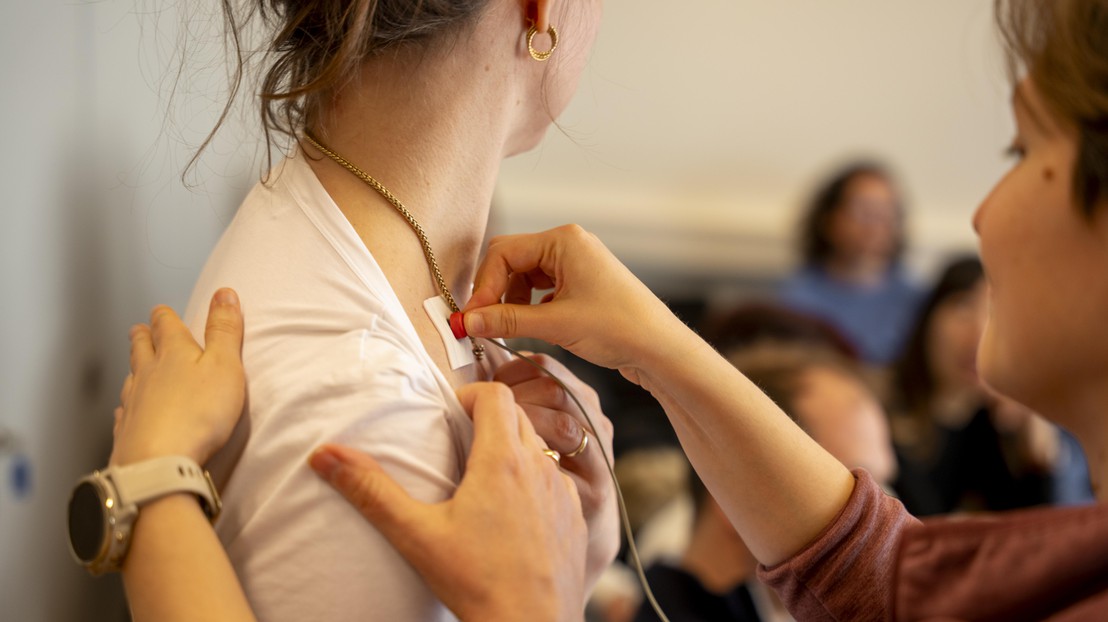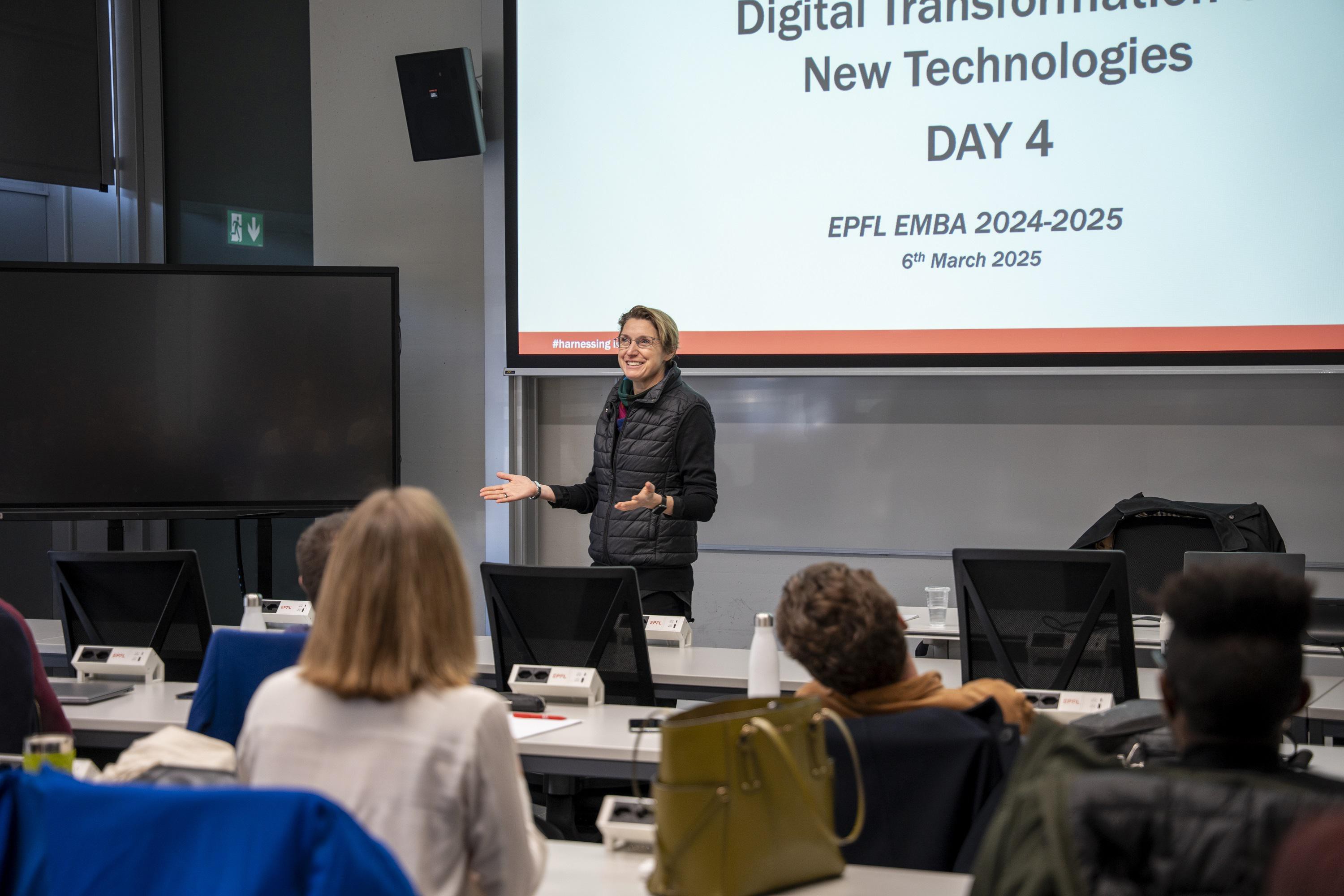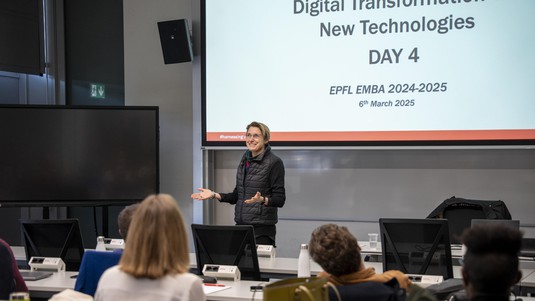A visit to the sources of digital transformation

© 2025 EPFL
Participants of the EMBA program at the College of Management of Technology had the opportunity to discover a selection of the latest technologies developed in EPFL's research laboratories. This enabled these professionals from different backgrounds to gain a better understanding of the long process between developing a cutting-edge product and bringing it to market.
There's nothing like seeing real-life examples, accompanied by explanations from passionate researchers, to help you understand the importance of disruptive or deep-tech technologies. These are the technologies that are profoundly transforming many sectors of society with their unprecedented scientific and technological solutions. That's why, every year, Andrea Dunbar, Professor of Practice at the College of Management of Technology, offers her EMBA cohort a day's visit to the EPFL campus, alongside her theory course dedicated to digital transformation and new technologies. A unique opportunity to discover the long and winding processes leading a deep-tech technology to its commercialization phase.
On Friday, March 7, 2025, a school run atmosphere reigns among the EMBA participants, as the class divides in two for the laboratory visits. On the agenda: the discovery of exoskeletons developed by the REHAssist (for Rehabilitation and Assistive Robotics) research group, headed by Dr. Mohamed Bouri, within the School of Engineering (STI), followed by the flagship projects of the Embedded Systems Laboratory associated with the Internet of Things (IoT,) headed by Prof. David Atienza, at the Institute of Electricity and Micro Engineering. Finally, the latest developments in fusion research at the Swiss Plasma Center are also included in the campus visit.

Understanding how deep tech works
“It's a really special day,” enthuses Andrea Dunbar as she leads her little troop to the first research venue. “Globally, we're interested in how technology finds its place in industry but also in society at large. That's why I also address ethical issues. Through laboratory visits, these professionals immerse themselves in the complexity of deep tech, in the interface between software and hardware. Digital transformation is accelerating all the time, and companies can be caught short or even lose competitiveness if they don't keep up. Here, we train tomorrow's technology managers. They need to understand how this system works, because it can disrupt their company's development”, she stresses. The selected laboratories thus demonstrate different levels of research, from the most abstract to the most concrete.
“One of my objectives is for participants to learn to ask the right questions about these new technologies, so they can distinguish the true from the false. With the advent of AI, the lines have become blurred.”
Treating thrombosis or monitoring epilepsy
The REHAssist research group's presentation of the various applications associated with medical robotics assistance introduced the class of 2025 to three doctoral projects. The first is a robotic tool that facilitates the extraction of clots during thrombosis, which is currently done manually. It quickly aroused interest, and medical, technological and financial questions were asked. The second, more visual, tool is placed directly on the body of the scientist in charge, as it is a lower-limb exoskeleton capable of assisting different ways of walking much like how an electric bicycle works. The third and final technology specializes in neuromodulation strategies. Among other things, it enables the development of non-invasive electrical stimulation of muscles and the spine for patients undergoing rehabilitation following a stroke.
Malene Kirstine Holst, active in the academic world and EMBA participant, finds these discoveries very inspiring, as they bring enormous benefits to society. “It's important to raise funding for deep-tech start-ups, as these are necessary long-term investments,” she explains.
In the Embedded Systems Laboratory, the presentation here focuses on IoT-related technologies that have passed the prototype or even commercialization stage. With a real passion for this research, Miguel Peon Quiros shows a dozen connected tools. Like a tablet linked to a person's electrocardiogram, which a participant agrees to wear as a demonstration. Since its initial functionality, the prototype has gradually evolved to meet doctors' demands and to be marketed.
But there's also the example of the creation of an intelligent water pipe network system featuring sensor-based technology, artificial intelligence and IoT. Or else glasses that offer non-invasive epilepsy monitoring thanks to advanced computing.
“I find it very interesting to see application cases that are not yet finished products. It becomes more tangible,” notes Kiflay Mengestabe, EMBA participant and consultant in the insurance sector. Fiorella Tolentino, who works for the United Nations, is equally enthusiastic: “It's exciting to understand how academia and industry are linked, and the different stages involved in bringing a product to funding and commercialization. These lab visits made the process much clearer.”
This highly enriching day of campus discovery ended on a musical note with Alain Dufaux's presentation of the Montreux Jazz digital project. The operational manager of EPFL's Cultural Heritage & Innovation Center explained all the work involved in digitizing and showcasing the incredible collection of recordings from the famous Montreux Jazz Festival, as well as its long-term preservation.







